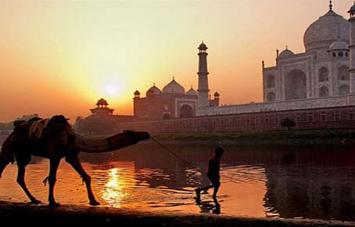Nepal General Info
Nepal, a Himalayan country, is situated on the slopes of the central Himalayas and represents about one third of its whole length. Nepal lies between China on the north and India on the east, south and west. It is located between the latitudes 26 ° 22' and 30 ° 27' N and longitudes 80 ° 40' and 88 ° 12' E. It is roughly rectangular in shape and occupies a total are of 147,181 sq. km. From 145-241 km with a mean of mean of 193 km. About 83 per cent of its total land area is occupies by the high mountain and wavy hills and remaining 17 per cent by flat lands of the Terai. The altitude varies from some 60 m above sea level in the Terai to 8,848 m the Mt. Everest , which is the highest peak of the world.
Nepal 's climate varies according to elevation. The Tarai of southern Nepal has a tropical monsoon climate characterized by rainy summers and the southwest winds of the monsoon, and almost dry winters. The effect of the southern monsoon climate extends northward into mountain valleys. In the Middle Himalayan valleys the amount of precipitation varies with the extent of exposure to the rain-bearing monsoon winds. Several high valleys located in the rain shadow (area where precipitation is partially blocked by mountains) are dry.
Nepal had a population of 18,462,081 at the time of the 1991 census. The average population density at the time was 125 persons per sq km (329 per sq mi), although nearly half the people were concentrated in the narrow Tarai region. In contrast, the 2003 population estimate was 26,469,569. The population has grown rapidly since 1950 when there were only 9 million people. Although the government has sponsored family planning since the 1950s, these programs have been slow to affect Nepal 's population growth.
Nepal 's indigenous population consists of two major groups, the Indo-Nepalese, whose ancestors migrated into the country from the south, and the Tibeto-Nepalese, whose ancestors entered Nepal from the north. Although intermingling between the two groups has occurred, cultural, linguistic, and religious differences exist both between and within the two groups. The Indo-Nepalese group comprises people who speak Sanskrit-derived languages and are strict adherents to Hinduism. Nepali, the official language, is derived from Sanskrit. Differences within the Indo-Nepalese group are marked more by caste (a system of social hierarchy) than by ethnicity. The Tibeto-Nepalese group comprises several different ethnic groups including Thakali, Newar, Bhutia, Sherpa, Gurung, Magar, Tamang, Rai, and Limbu people. Although most of the Tibeto-Nepalese speak Nepali, each ethnic group also has its own language. While the majority of Nepali people practice Hinduism, the official religion, a strong Shamanist element remains in the religious practices of many Tibeto-Nepalese ethnic groups. Buddhism is also important within the country. Buddha, the founder of Buddhism, was born in Lumbini, in present-day Nepal . There is also a small Muslim population mainly located in the Tarai.
Culture, Conduct and Consideration
Nepal has always been a dividing line between cultures and civilizations, and a cross-roads for the commerce and culture. Here the plains of the subcontinent climb up to the high plateau of Tibet, the languages and people of India give way to those of China and the Hindu religion blends in to Buddhism. Nepal is often a complex blend of the two influences and this variation is further complicated by the diversity of ethnic groups within the country.
The challenge for you as a visitor to Nepal is the respect the rights and beliefs of the local people, and to minimize your impact - culturally and environmentally. Remember Nepali is not an adventure park or museum established for your convenience, but home to a vital, changing culture. Life for many is extremely hard, but despite the scarcity of material possessions, there are many qualities that shame the so-called developed world. Your very presence in Nepal will have an effect - an increasing number of people say a negative one. In a totally different culture it is also inevitable that the visitor will make some gaffe at some point. Most Nepalis make allowances, but they do appreciate it when a genuine effort is made to observe local customs. Following is a miscellaneous collection of simple suggestions that will help avoid offense.
Always remove your shoes before entering a Nepali home. Dress appropriately - shorts or revealing clothing are never suitable for women. Shorts are acceptable for men only when trekking; going without a shirt anywhere is not.
















